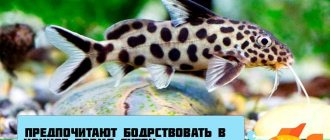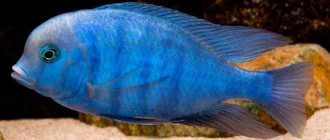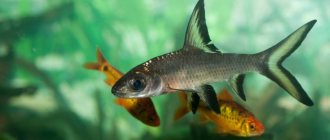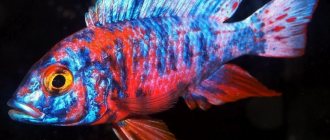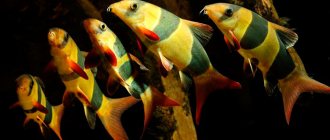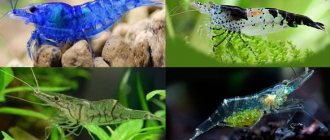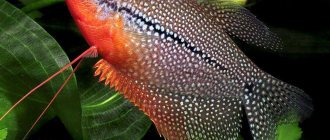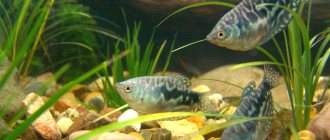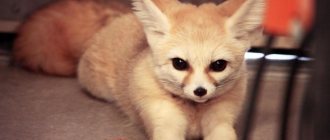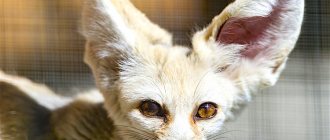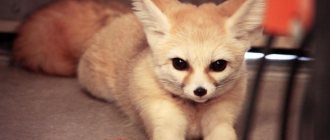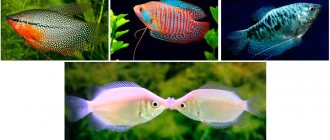To ensure a peaceful atmosphere in the aquarium, when selecting fish, it is necessary to take into account their compatibility. Otherwise, constant skirmishes and even the death of one or more fish are possible. When populating an aquarium, it is better to use the recommendations of specialists. For example, they assess the compatibility of gourami with other fish as high, but at the same time, their neighbors must be peaceful.
Neighbors for these fish should be peaceful
Compatible with each other
Fish are not very compatible with each other.
Males are hostile to each other. Males compete for the attention of females and conquer territories. In females, mutual hostility is observed less frequently. Place three females per male. You can keep macropods of one species or several compatible species:
- marble;
- lunar;
- pearl;
- honey;
- spotted
Spotted and pearl, as well as blue and pearl, form hybrids.
Feeding Lalius
The basis of the diet of lalius in nature are insects, their larvae, fish fry, and plankton. Fish will not disdain the succulent parts of green plants.
Like their close relatives gourami, lalius have an interesting way of obtaining food - they are able to hunt insects flying over water. From the outside, the process looks like this: the fish freezes near the surface of the water and waits for its prey. As soon as the victim is detected and appears within reach, the lalius releases a stream of water and knocks down the insect.
When keeping lalius in an aquarium, it is necessary to provide them with a complete, balanced and varied diet. When feeding, it is necessary to take into account that the fish have a small mouth, so the food should be of such a size that the fish can easily swallow it. In Tetra's assortment you can easily find dry food that will fully satisfy the nutritional needs of your little ones.
TetraPro Color is an innovative food in the form of chips, produced using gentle low-temperature technology, which allows you to preserve even more nutrients. Thanks to this, Lalius receive food with an optimal ratio of proteins, fats, carbohydrates and vitamins. Excellent feed digestibility reduces the amount of fish waste, and therefore the water in the aquarium will remain clean for a longer time. The chips contain a concentrate of natural dyes that enhance the natural coloring of the fish, making the male lalius look even brighter.
Do not forget also that plant components must be present in the diet of Lalius. TetraPro Algae food is well suited for this purpose. It contains spirulina algae, which helps diversify the diet of fish. Both foods crumble perfectly in your hands, which allows you to choose the right fraction for feeding fish of any size.
It is necessary to feed Lalius several times a day with such an amount of food that they can completely eat in a few minutes.
Who are they compatible with?
Ideal neighbors for gourami are peaceful fish of similar sizes (10–15 cm, with the exception of the Giant Gourami, which grows to 40–70 cm). Cohabitants that are too small will become food for labyrinths, and large predators will become a source of constant stress.
Soma Corydoras
Peaceful and leisurely catfish can boast full compatibility with many species of fish. Corydoras live in the lower layers of water, labyrinthine ones live in the upper and middle layers, so contacts between neighbors are kept to a minimum.
Danio
Full compatibility with peaceful and active fish. Zebrafish prefer cool water. Suitable temperature for neighbors is 22–24 degrees.
Mollies
Mollies are similar in size to labyrinths. Males are aggressive within the species, but friendly towards members of other species. Choose comfortable water for both species: molly prefers medium-hard water.
Kinds
Keeping neons in an aquarium attracts fans of the aquatic world not only due to their bright colors, but also due to the abundance of varieties of neons. Species that have gained popularity in the aquarium hobby:
Blue, or common neon, is the most sought-after variety, which was first discovered by Auguste Barot. The color of the variety is bright: there is a neon line along the body, under which there is a scarlet stripe from the center of the body to the tail. Representatives grow up to 4 cm in length.
Golden is a golden colored morph of the common variety. A stripe runs along the body, which in the light gives off a golden appearance. Representatives of the species stretch up to 4 cm in length.
Diamond is a variety bred by breeders. The head of the phenotype is blue, with a scarlet stripe with a matte tint running along the sides. The main tone of the scales is silver with a sapphire sheen. It reaches 4 cm in length.
Veiled is an artificially bred variety. A distinctive feature is the developed lush fins; the species is considered rare and expensive.
Red – representatives of red neons have a rich color. Like the blue one, the red fish has a reflective stripe, under which there is a wide crimson line. The fins of the fish are transparent, the back is green.
Black neons are aquarium fish that grow up to 4 cm. The color of the body is black-emerald, the abdomen is light. The body is decorated with two lines: silver and jet black.
Green - In the wild, inhabits the waters of the Amazon. The main color tone is silver-green, with a green stripe along it. The tail has a dark spot with a golden dot, the fins are uncolored.
Blue - miniature fish, growing up to 3.5 cm in length. The appearance is similar to the red or blue variety, the phenotype has a luminous blue stripe.
Orange is a subspecies of red neon. The body is colored orange, with dark blue spots scattered throughout the body. The stripe of the orange neon is not as bright as that of other species.
False blue - the appearance is similar to the ordinary variety, but the scarlet stripe is not so pronounced. The dominant color is blue.
Limited compatibility
Angelfish
Conditional compatibility. Aquarium angelfish show aggression during spawning. Gourami get along with aquarium fish in a spacious aquarium.
Barbs
Barbs are prone to biting off gourami fins, so provide the fish with enough free space. Shelters and plants are required.
Labeo
Labeo prefers a solitary lifestyle and has a territorial disposition. Conditional compatibility if there is a spacious tank.
Rasbory
Good compatibility with some analysis. Place a flock of rasboras in soft, slightly acidic water. Choose large species such as shiny, variegated or elegant.
Snails
Macropods eat small mollusks, so introduce snails with caution.
Botsiya
Bots get along with gouramis, but it is worth monitoring the behavior of the fish to see if conflicts arise.
Guppy
These livebearers are smaller in size than swordtails and platies. They are incompatible with giant gouramis and guppies. Guppies cannot escape attacks from them.
Fish health is most important
Females need to spawn, otherwise they may die.
When adding other fish to gourami, it is worth thinking about how they will spawn, because one way or another, the fish need to spawn and this requires appropriate conditions. If one species conflicts with another, it may take months before the fish begin to spawn normally. Beginners in the aquarium hobby sometimes do not know that it is necessary to spawn fish not for sale, but for the health of the females. After spawning, the fish must be removed immediately so that they do not eat the eggs. Cases of cannibalism are not uncommon. Suitable conditions must be created for spawning. If these conditions do not exist, then if the female does not lay ripe eggs, they will begin to decompose directly in her body . In 100% of cases for small individuals (up to 5 cm) this ends in death. If the female is larger, then there is a chance to express the eggs by contacting a specialist.
Incompatible fish
Labyrinths are incompatible with the following types of aquarium inhabitants:
- Cockerels. The fish are similar in structure of the respiratory organ. However, due to their temperament, cockerels do not get along well with anyone. Living with gourami in the same aquarium is also impossible.
- African and South African cichlids. Temperamental and territorial cichlids, often reaching 30 cm, are the worst neighbors for labyrinths.
- Astronotuses. Large predators chase and maim gouramis.
- Discus. Conflicting natives of the cichlid genus provoke skirmishes, especially during spawning.
- Goldfish. Labyrinth fish will have conflicts with those with veil fins.
- Koi carp. Carps that reach impressive sizes will eat small companions.
- Acne. The temperament of eels is not suitable for keeping together with macropods.
Why do conflicts happen?
If you organize life in an aquarium correctly, you can avoid both clashes between fish of different species and intraspecific conflicts. Conversely, violation of the maintenance rules leads to quarrels, especially if relatively compatible species live in the aquarium.
The main causes of aggression and conflicts:
- cramped aquarium;
- lack of algae and shelters;
- bright colors or long fins of neighbors in the aquarium;
- too big difference in size;
- lack of feed;
- water parameters do not correspond to the norm;
- presence of offspring during spawning.
Choosing the right neighbors is a prerequisite for the prosperous existence of all inhabitants of the aquarium. If you want your pets to be alive and healthy, use fish compatibility tables and stock aquariums with species that can coexist peacefully with each other.
Vegetation
Macropods come from bodies of water with dense vegetation. Females often hide there. Make sure that the volume of the aquarium allows you to fill 65–80% of the space with flora, providing the inhabitants with free movement. It is desirable to have floating plants like Riccia or Wolfia. Sometimes fish spoil plants, they especially like:
- ambulia;
- Blixu;
- pellia;
- hornwort;
- duckweed
You can lure gourami's interest in aquarium plants with lettuce leaves and plant food in tablets.
Content Features
The most suitable living conditions for gourami would be to recreate their natural biotope. In Southwest Asia, these fish are found in shallow waters with an abundance of vegetation and rotting organic matter. That is why they have such developed pelvic fins, reminiscent of long thin tentacles, and atmospheric breathing. In the aquarium, labyrinths do not require aeration at all. They prefer old water, so frequent changes are not necessary.
Don't forget to set up the appropriate fish habitat
Since the fish are tropical, the water temperature must be maintained in the range of 24−26°C. The acidity level should be 6.5−7 pH. It is desirable that the soil is dark in color. The lighting should be bright and located on top, not on the side of the aquarium. In such conditions, gourami acquires the most saturated color and looks very impressive. Under good conditions, these representatives of the labyrinths are able to live in captivity for up to 7-10 years.
In this video you will learn more about gourami:
Feedback on gourami compatibility
The experience of aquarists varies greatly. Someone keeps gourami in the amount of 5-8 individuals, and no aggressive behavior is observed.
Some aquarists have encountered aggression from males towards young females. Some breeders have success keeping two male gouramis in a large aquarium.
There are cases of keeping gouramis with guppies, in which the former bite the fins of small fish.
Eating snails happens, but aquarists note that gouramis are not very effective in combating multiplied mollusks.
What you should pay attention to
Aquarium volume
When keeping goldfish, a large aquarium volume is very important. This is due to the fact that representatives of certain breeds can grow up to 20 cm, and besides, goldfish are unusually voracious, which means they release a lot of waste into the water. Maintaining balance in such conditions, especially in small volumes, will require significant effort. Therefore, when purchasing goldfish, keep in mind that the minimum volume of the aquarium per individual should be at least 30 liters.
Source
Breeding/reproduction
Like most gourami, the male creates a nest on the surface of the water from small sticky air bubbles where the eggs are deposited. For successful breeding, you should prepare a separate spawning tank with a volume of about 80 liters or slightly less. Fill with water from the main aquarium to a height of 13–15 cm. The water parameters must match those of the main aquarium. The equipment is standard: lighting system, aerator, heater, filter that produces a weak flow of water. In the design, it is recommended to use floating plants with small leaves, for example, richia, they will become part of the nest. The incentive to spawn is the inclusion of meat products (live or frozen) in the daily diet. After some time, when the female is noticeably rounder, the pair is placed in a separate tank, where the male begins building a nest. Upon completion of construction, the male begins courtship - he swims back and forth near the female, lifting his tail above his head, touching his fins. The female lays up to 800 eggs in the nest, after which she is removed back to the main aquarium, the male remains to protect the clutch, he joins the female only after the fry appear.
Habitat
Habitats in nature are small warm reservoirs, sewers, swamps, poor in oxygen in Southeast Asia: Cambodia, Sumatra, Borneo, Thailand, Vietnam. Such waters are relatively safe: few fish are able to live in water of poor quality. There is enough food there. And the problem of a small amount of oxygen is solved this way: gourami often floats to the surface, swallows a bubble of oxygen and returns to the middle layer. The name "gourami" translates as "fish that sticks its nose out of the water."
Appearance
Macropods are quite large aquarium fish. The body length of males can reach 10 cm, females – 8 cm. The body is elongated and strong. The head is pointed, with large eyes. The unpaired fins (caudal, anal and dorsal) are well developed. The tail can reach 3 cm in length, which visually makes the fish even larger. The pectoral fins are transparent, and the abdominal fins are modified into thin threads and act as organs of touch, allowing them to navigate in muddy water.
Macropod. Appearance
The coloration of the macropods deserves special attention. The main body color is blue or deep olive with numerous transverse red stripes. The unpaired fins are bluish-red, and there may be white spots on the tail. Near the gills there is a shiny blue eye surrounded by a red spot. We are talking primarily about males; females are much more modestly colored. The intensity of color depends on the water temperature and the degree of excitement of the fish. Breeders have obtained a number of color variations, for example, albinos, which do not differ in content from the classic form.
The average life expectancy is 5 years.
Feeding Neons
High-quality dry food is excellent for feeding neons at home. It is not recommended to use frozen and live ones, because they do not contain the full range of nutrients and can easily become a source of infection in the aquarium.
Neons are fish with a small mouth, which must be taken into account when choosing food. You can opt for the following foods:
- Tetra Micro Crisps is food in the form of chips for small ornamental fish. Fully balanced, contains natural color enhancers and herbal ingredients to maintain the health and vitality of your fish. The small chips soften quickly, making them easy for Neons to eat.
- TetraPro Energy is a highly nutritious food in the form of chips, manufactured using a special low-temperature technology, which allows you to retain even more nutrients. The center of the chips contains an energy concentrate to keep your neons always active.
- TetraMin Mini Granules are a basic food for all types of small tropical fish. The pellets sink slowly, making it easy for fish to collect them. Made from a mixture of more than 40 components of high quality raw materials. Contains prebiotics for the proper functioning of the fish's gastrointestinal tract, and the special BioActive formula supports a healthy immune system.
It is best to feed Neons 2-3 times a day with a small portion of food, which will be completely eaten in a couple of minutes. You should not overfeed your pets, they are prone to obesity.
Diseases
Fish have good immunity, which decreases under unfavorable conditions. Gourami diseases are standard:
- Ichthyophthyriosis - infection caused by dirty equipment and decor;
- Fin rot – non-compliance with temperature conditions, introduction of sick fish;
- Aeromonosis – due to overcrowding;
- Hexamitosis is a parasitic infection that requires urgent treatment. It manifests itself in the restlessness of the fish, they experience itching and rub against the surface;
- Ichthyosporidiosis is a parasitic infection;
- Lymphocystis is a mild parasitic infection that does not require treatment;
- Ligulosis - due to low-quality food (daphnia).
Treatment is mainly with antibiotics (kostapur, baktopur). After treatment, restoration with good food is required.
Photo
STRIPED GOURAMI
GIANT GURAMI
BLUE OR SUMATRAN GOURAMI
BROWN GOURAMI
GRUMMING GURAMI
CHOCOLATE GOURAMI
MOON GURAMI
Dwarf gourami
LALIUS
KISSING GURAMI
GOLDEN GOURAMI
MARBLE GURAMI
HONEY GOURAMI
PEARL GOURAMI
conclusions
For correct content, follow the rules:
- Avoid changing large volumes of water. Changes in the aquatic environment should occur smoothly.
- Adapt your newly acquired fish by placing the transport bag in an aquarium with water for half an hour. When the temperature has leveled off, add a little aquarium water to the bag with the fish, and after 15 minutes add a little more liquid. Before completely moving the fish into the aquarium, perform at least three top-ups.
- When purchasing food, check the expiration date. Do not take feed in bulk.
- If the fish jumps out of the aquarium, place it in a separate container with water from the general aquarium. Don't disturb your pet.
- If the filter creates a strong current, place the device on the back wall of the aquarium, pointing the tube into a corner.
Macropod is a good candidate for the role of the first aquarium fish, if the peculiarities of its structure and temperament are taken into account. The labyrinth fish will forgive the mistakes of novice aquarists and will survive infrequent aquarium maintenance. However, remember that fish are living creatures that require care and responsibility.
Description
External characteristics of the species: large elongated body, laterally compressed, the mouth is located in the upper position. The dorsal and anal fins stretch from head to tail and are large. The pelvic fins have thin long rays for orientation in space: with them the fish probes the bottom surface and thickets of plants. There are many species of gourami, including those that have successfully taken root in home aquariums. The largest is called brown (giant gourami), in nature it reaches 30 cm, aquarium specimens grow up to 17 cm. The remaining species are smaller, on average 7-10 cm.
